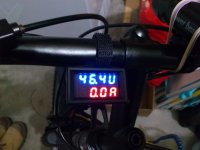Going home with the resistor switched out using the 10s battery was fine. Just like normal.
When I worked out what resistor I was going to go for yesterday, I tried 1kohm ones in parallel at first, because that was the lowest value I had in my box of bits. They were only little quarter watt ones, and when I only had one or two together, with a full 12s battery, they were getting pretty hot. It took 4 of those in parallel to get the voltage down to below 46v.That made 250ohms.
The nearest to that, I could buy in the 5watt ones were 220, or 270, so I got both. I tried the 220 first, but it was still too much volts, and it wouldn't go, but the 270ohms did the trick. I did try hooking the motor up to see what current I was pulling through the on/off switch, and with it running, I only got max .06amps. I should have checked the voltage on the controller side of the resistor at that stage. Maybe I'll try doing that next.
I might have an LM317 in my box, I think that's adjustable, but I think it will only go up to 37v. Thats a big drop from 50v, so I expect it would need a pretty good heatsink.
Also it has to have a supply voltage at least 3v over the output, so it would only be useful down to 40v battery voltage.
I'll do a bit of poking around, and see if I can find a more suitable voltage reg IC.
I tried searching R12 Mod & R12 on the forums, and didn't get any hits.
When I worked out what resistor I was going to go for yesterday, I tried 1kohm ones in parallel at first, because that was the lowest value I had in my box of bits. They were only little quarter watt ones, and when I only had one or two together, with a full 12s battery, they were getting pretty hot. It took 4 of those in parallel to get the voltage down to below 46v.That made 250ohms.
The nearest to that, I could buy in the 5watt ones were 220, or 270, so I got both. I tried the 220 first, but it was still too much volts, and it wouldn't go, but the 270ohms did the trick. I did try hooking the motor up to see what current I was pulling through the on/off switch, and with it running, I only got max .06amps. I should have checked the voltage on the controller side of the resistor at that stage. Maybe I'll try doing that next.
I might have an LM317 in my box, I think that's adjustable, but I think it will only go up to 37v. Thats a big drop from 50v, so I expect it would need a pretty good heatsink.
Also it has to have a supply voltage at least 3v over the output, so it would only be useful down to 40v battery voltage.
I'll do a bit of poking around, and see if I can find a more suitable voltage reg IC.
I tried searching R12 Mod & R12 on the forums, and didn't get any hits.






